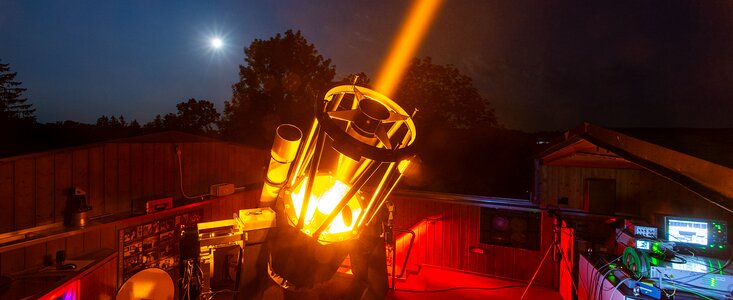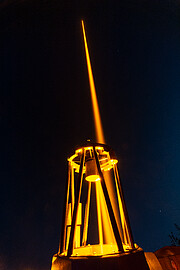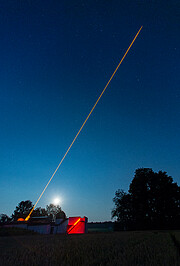Mitteilung
Neuer leistungsstarker Laser auf der Grundlage von ESO-Technologie besteht Praxistest
31. August 2021
Ein leistungsstarker experimenteller Laser, der auf der Technologie der ESO basiert, hat letzten Monat einen wichtigen Test an der Allgäuer Volkssternwarte Ottobeuren bestanden. Der Laser für Adaptive Optik, der in Zusammenarbeit mit der Industrie entwickelt wurde, verfügt über wichtige zusätzliche Eigenschaften im Vergleich zu bestehenden Systemen. Er wird Teil des adaptiven Optiksystems CaNaPy Laser Guide Star sein, das im Rahmen der Forschungs- und Entwicklungszusammenarbeit zwischen ESO und ESA an der Optical Ground Station der Europäischen Weltraumorganisation ESA auf Teneriffa installiert werden soll. Die höhere Laserleistung, die fast dreimal so hoch ist wie bei derzeitigen Systemen, ermöglicht neue Entwicklungen im Bereich der Laser-Satellitenkommunikation sowie eine erhebliche Verbesserung der Schärfe astronomischer Bilder, die mit bodengestützten Teleskopen aufgenommen werden.
In der Astronomie bezieht sich der Begriff Adaptive Optik auf Systeme an bodengebundenen Teleskopen, die den durch Turbulenzen in der Erdatmosphäre verursachten Unschärfeeffekt korrigieren - denselben Effekt, der die von der Erde aus gesehenen Sterne zum "Funkeln" bringt. Um die Verzerrungen zu beseitigen, benötigen diese Systeme einen hellen Referenzstern in der Nähe des zu untersuchenden Objekts. Da diese Sterne nicht überall am Himmel zu finden sind, regen die Astronomen mit Hilfe von Lasern Natriumatome in 90 km Höhe in der Erdatmosphäre an und erzeugen so künstliche Sterne in der Nähe des Untersuchungsobjekts, die zur Kartierung und Korrektur der atmosphärischen Turbulenzen verwendet werden können.
Der neue Versuchslaser basiert auf derselben ESO-Technologie wie die Four Laser Guide Star Facility, die am Very Large Telescope der ESO in Chile sowie an den meisten großen astronomischen Observatorien der Welt erfolgreich in Betrieb ist. Doch während diese Laser eine Leistung von 22 Watt haben, hat der neue Laser mit 63 Watt fast die dreifache Leistung. Dies ist ein enormer Fortschritt in der astronomischen Lasertechnologie, der unter anderem die Schärfe der Bilder der Adaptiven Optik bei sichtbaren Wellenlängen verbessern wird. Im Rahmen einer Forschungs- und Entwicklungskooperation mit der ESO konnte das kanadische Unternehmen MPB Communications - einer der Industriepartner der ESO - die Leistung seiner Infrarot-Raman-Faserverstärker-Quelle erhöhen. Dies ist der Durchbruch, der es dem CaNaPy-Laser der ESO ermöglicht, eine so hohe Leistung zu erreichen [1].
Darüberhinaus hat das deutsche Unternehmen TOPTICA Photonics AG, ein weiterer Industriepartner der ESO, im Rahmen einer Forschungs- und Entwicklungskooperation mit der ESO ein Frequenz-Chirping-System für diese neue Laserklasse entwickelt und in den CaNaPy-Laser integriert. Beim Chirping wird die Frequenz, auf die der Laser abgestimmt ist, schnell geändert. Dadurch wird die Anzahl der vom Laser angeregten Natriumatome erhöht, wodurch der künstliche Stern heller wird und die Turbulenzkorrektur verbessert wird. TOPTICA hat den Chirping-Prototyp auf dem 63-Watt-Laser installiert und zusammen mit der ESO sowohl den Laser als auch sein neuartiges Chirping-System am Himmel in Betrieb genommen.
Der neue experimentelle CaNaPy-Laser ist ein Beispiel für eine astronomische Technologie, die von der ESO in Zusammenarbeit mit der Industrie entwickelt und dann in die industrielle Nutzung, auch in neuen Bereichen, überführt wurde und somit der Gesellschaft als ganzes zugute kommt. Sobald das CaNaPy-Instrument an der Optical Ground Station der ESA auf Teneriffa installiert ist - ein Gemeinschaftsprojekt der ESO [2] und der ESA - wird es beiden Organisationen, der ESA und der ESO, die Möglichkeit bieten, den Einsatz von Technologien der Adaptiven Optik mit Laserleitsternen nicht nur für die Astronomie, sondern auch für die optische Satellitenkommunikation voranzutreiben. Die optische Laserkommunikation ermöglicht es Satelliten, Signale mit ultraschneller Bandbreite von und zur Erde zu senden und zu empfangen - eine Perspektive, die von der ESA untersucht wird. Optische Lasersignale können viel mehr Informationen übertragen als Radiosignale, werden aber ebenso von atmosphärischen Turbulenzen beeinträchtigt. Die Adaptive Optik von Laserleitsternen hat daher das Potenzial, die optischen Verbindungen zwischen Satelliten und Bodenstationen erheblich zu verbessern.
Endnoten
[1] MPB Communications hat die Leistung seines Raman-Faserverstärkers, der im Infraroten bei 1178 nm arbeitet, von den 36 Watt, die normalerweise bei den kommerziellen Natrium-Laserleitsternen verwendet werden, auf eine noch nie dagewesene Leistung von 100 Watt erhöht. Damit kann CaNaPy im sichtbaren Bereich bei 589 nm eine Dauerstrichleistung von 63 Watt erreichen.
[2] An der Zusammenarbeit sind mehrere Institute in ESO-Mitgliedsländern beteiligt: das Istituto Nazionale di Astrofisica in Italien, die Durham University in Großbritannien und das Instituto de Astrofísica de Canarias in Spanien.
Links
- Artikel im ESO-Messenger: Laser Development for Sodium Laser Guide Stars at ESO
- ESA Hydron Project
- Allgäuer Volkssternwarte Ottobeuren
- MPB Communications
- TOPTICA Photonics AG
Kontaktinformationen
Domenico Bonaccini Calia
Physiker in der Laser and Photonics Group bei der ESO
Garching bei München
E-Mail: dbonacci@eso.org
Juan Carlos Muñoz Mateos
ESO Media Officer
Garching bei München
E-Mail: jmunoz@eso.org
Über die Mitteilung
| ID: | ann21011 |
Our use of Cookies
We use cookies that are essential for accessing our websites and using our services. We also use cookies to analyse, measure and improve our websites’ performance, to enable content sharing via social media and to display media content hosted on third-party platforms.
ESO Cookies Policy
The European Organisation for Astronomical Research in the Southern Hemisphere (ESO) is the pre-eminent intergovernmental science and technology organisation in astronomy. It carries out an ambitious programme focused on the design, construction and operation of powerful ground-based observing facilities for astronomy.
This Cookies Policy is intended to provide clarity by outlining the cookies used on the ESO public websites, their functions, the options you have for controlling them, and the ways you can contact us for additional details.
What are cookies?
Cookies are small pieces of data stored on your device by websites you visit. They serve various purposes, such as remembering login credentials and preferences and enhance your browsing experience.
Categories of cookies we use
Essential cookies (always active): These cookies are strictly necessary for the proper functioning of our website. Without these cookies, the website cannot operate correctly, and certain services, such as logging in or accessing secure areas, may not be available; because they are essential for the website’s operation, they cannot be disabled.
Functional Cookies: These cookies enhance your browsing experience by enabling additional features and personalization, such as remembering your preferences and settings. While not strictly necessary for the website to function, they improve usability and convenience; these cookies are only placed if you provide your consent.
Analytics cookies: These cookies collect information about how visitors interact with our website, such as which pages are visited most often and how users navigate the site. This data helps us improve website performance, optimize content, and enhance the user experience; these cookies are only placed if you provide your consent. We use the following analytics cookies.
Matomo Cookies:
This website uses Matomo (formerly Piwik), an open source software which enables the statistical analysis of website visits. Matomo uses cookies (text files) which are saved on your computer and which allow us to analyze how you use our website. The website user information generated by the cookies will only be saved on the servers of our IT Department. We use this information to analyze www.eso.org visits and to prepare reports on website activities. These data will not be disclosed to third parties.
On behalf of ESO, Matomo will use this information for the purpose of evaluating your use of the website, compiling reports on website activity and providing other services relating to website activity and internet usage.
Matomo cookies settings:
Additional Third-party cookies on ESO websites: some of our pages display content from external providers, e.g. YouTube.
Such third-party services are outside of ESO control and may, at any time, change their terms of service, use of cookies, etc.
YouTube: Some videos on the ESO website are embedded from ESO’s official YouTube channel. We have enabled YouTube’s privacy-enhanced mode, meaning that no cookies are set unless the user actively clicks on the video to play it. Additionally, in this mode, YouTube does not store any personally identifiable cookie data for embedded video playbacks. For more details, please refer to YouTube’s embedding videos information page.
Cookies can also be classified based on the following elements.
Regarding the domain, there are:
- First-party cookies, set by the website you are currently visiting. They are stored by the same domain that you are browsing and are used to enhance your experience on that site;
- Third-party cookies, set by a domain other than the one you are currently visiting.
As for their duration, cookies can be:
- Browser-session cookies, which are deleted when the user closes the browser;
- Stored cookies, which stay on the user's device for a predetermined period of time.
How to manage cookies
Cookie settings: You can modify your cookie choices for the ESO webpages at any time by clicking on the link Cookie settings at the bottom of any page.
In your browser: If you wish to delete cookies or instruct your browser to delete or block cookies by default, please visit the help pages of your browser:
Please be aware that if you delete or decline cookies, certain functionalities of our website may be not be available and your browsing experience may be affected.
You can set most browsers to prevent any cookies being placed on your device, but you may then have to manually adjust some preferences every time you visit a site/page. And some services and functionalities may not work properly at all (e.g. profile logging-in, shop check out).
Updates to the ESO Cookies Policy
The ESO Cookies Policy may be subject to future updates, which will be made available on this page.
Additional information
For any queries related to cookies, please contact: pdprATesoDOTorg.
As ESO public webpages are managed by our Department of Communication, your questions will be dealt with the support of the said Department.



